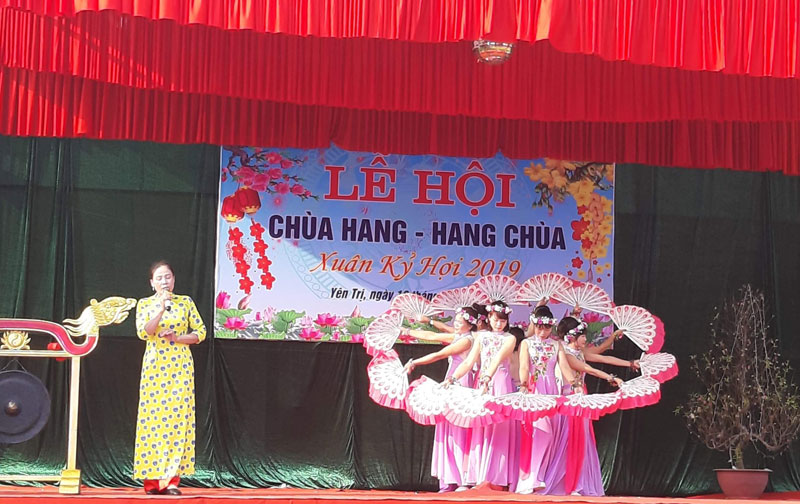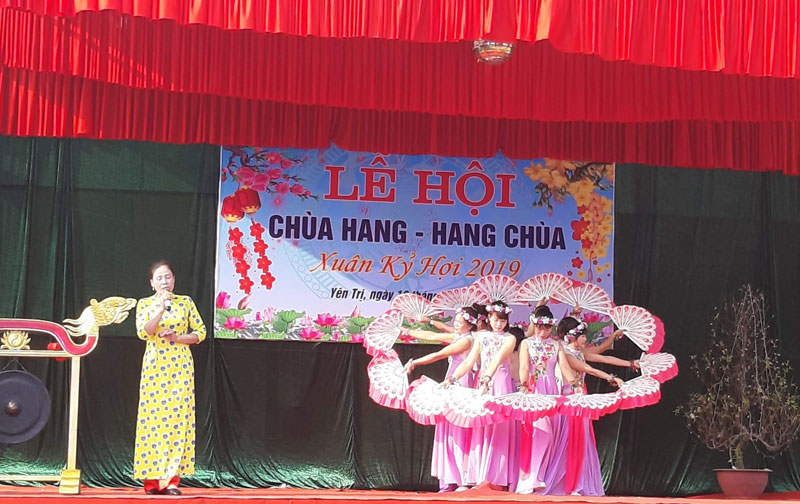
(HBO) - The Hang Pagoda - Chua Cave Festival kicked off in Yen Tri commune, Yen Thuy district of Hoa Binh province on February 19 (the 15th day of the first lunar month).
Hang Pagoda was recognized as a national
historical and cultural relic site by the Ministry of Culture and Information
(now the Ministry of Culture, Sports and Tourism) in 1994. The pagoda,
including two ancient pagodas, is located on a cliff. It was built by predecessors
a long time ago and was embellished during the reign of King Khai
Dinh.
During the two resistance wars against the French colonialists and the American
imperialists (1955-1975), Hang Pagoda served as the headquarters of the Vietnamese
army and was the place where the army hid weapons and food to serve the
resistance wars.

Art performance at the festival
The Hang Pagoda festival offers a chance
for tourists and local people to visit the pagoda. Everyone offers an incense to express their
respect to the Buddha, and pray for health, happiness and prosperity.
The festival includes incense and flower offerings
to pray for peace and health. Meanwhile, festive activities are art and culture
performances and volleyball competitions among teams of hamlets in the commune./.
With an increasingly vibrant and widespread emulation movement aimed at building cultured residential areas and cultured families, Yen Thuy District has been making steady progress toward improving both the material and spiritual well-being of its people, while fostering a civilized, prosperous, beautiful, and progressive community.
Once lacking recreational spaces and community facilities, Residential Group 2 in Quynh Lam Ward (Hoa Binh City) has recently received attention for the construction of a new, spacious, and fully equipped cultural house. The project followed the model of state support combined with public contributions in both labor and funding.
The "All people unite to build cultural life" movement, which has been effectively integrated with Kim Boi district’s socio-economic development goals, is fostering a lively spirit of emulation across local residential areas, hamlets, villages, public agencies, and enterprises. In addition, through the initiative, traditional cultural values are being preserved and promoted, while community solidarity and mutual support in poverty reduction and economic development are being strengthened.
A working delegation of the Hoa Binh provincial People’s Committee led by its Permanent Vice Chairman Nguyen Van Toan on June 11 inspected the progress of a project to build the Mo Muong Cultural Heritage Conservation Space linked to tourism services in Hop Phong commune, Cao Phong district.
Born and growing in the heroic land of Muong Dong, Dinh Thi Kieu Dung, a resident in Bo town of Kim Boi district, in her childhood was nurtured by the sweet lullabies of her grandmother and mother. These melodies deeply imprinted on her soul, becoming an inseparable part of her love for her ethnic group's culture. For over 20 years, this love for her hometown has driven Dung to research, collect, and pass down the cultural values of the Muong people to future generations.
In the final days of May, the Ethnic Art Troupe of Hoa Binh Province organized performances to serve the people in remote, mountainous, and particularly disadvantaged areas within the province. These were not just ordinary artistic shows, but they were the meaningful journeys aimed at spreading cultural values, enhancing the spiritual life of the people and contributing to the preservation of ethnic minority cultural identities.



